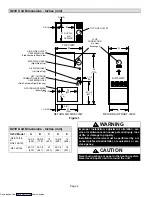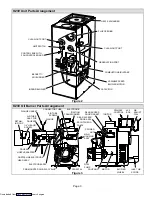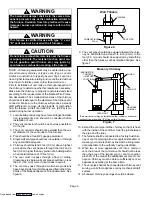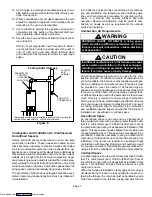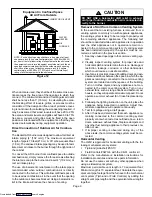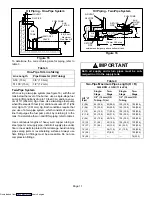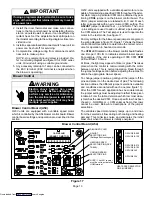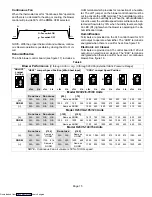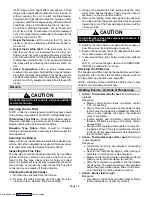
Page 7
15. All vent pipe run through unconditioned areas or out-
side shall be constructed of factory built chimney sec-
tions. See figure 8.
16. Where condensation of vent gas is apparent, the vent
should be repaired or replaced. Accumulation of con-
densation in the vent is unacceptable.
17. Vent connectors serving this appliance shall not be
connected into any portion of mechanical draft sys-
tems operating under positive pressure.
18. Keep the area around the vent terminal free of snow,
ice and debris.
NOTE − If vent pipe needs to exit from side of cabinet,
use the pilot hole (located on either side of the unit) to
cut a 6" (152 mm) round hole. Attach finishing plate
(provided) with four sheet metal screws to cover rough
edges.
Factory−built Chimney
BAROMETRIC
CONTROL*
(IN EITHER
LOCATION)
DRAIN FOR
CONDENSATE
FACTORY
BUILT
CHIMNEY
Figure 8
*Barometric control may be installed in either vertical or horizontal
section of flue pipe within 18" of flue outlet of furnace.
Combustion and Ventilation Air (Confined and
Unconfined Spaces)
Homes built with energy conservation in mind use tight
construction practices. These houses are sealed so well
that it becomes necessary to provide a means of bringing
in air from outside for combustion. Also, exhaust fans, ap-
pliance vents, chimneys and fireplaces force additional air
that could be used for combustion out of the house. Unless
outside air is brought into the home for combustion, nega-
tive pressure (pressure outside is greater than inside pres-
sure) will build to the point that a down draft can occur in the
furnace vent pipe or chimney. Combustion gases enter the
living space creating a potentially dangerous situation.
The importance of the previous paragraph cannot be over-
stated. Users may inadvertently block fresh air intakes af-
ter installation.
In the absence of local codes concerning air for combus-
tion and ventilation, the following section outlines guide-
lines and recommends procedures for operating oil fur-
naces in a manner that ensures efficient and safe
operation. Special consideration must be given to com-
bustion air needs as well as requirements for exhaust
vents and oil piping.
Combustion Air Requirements
WARNING
PERSONAL INJURY OR DEATH! A living space
which provides insufficient combustion air to the
furnace can result in headaches, nausea, dizziness
or asphyxiation.
CAUTION
Insufficient combustion air to the furnace can cause
excess water accumulation in the heat exchanger,
resulting in rusting and premature heat exchanger
failure. It can also cause property damage.
All oil-fired appliances require air to be used for the com-
bustion process. If sufficient amounts of combustion air
are not available, the furnace or other appliance will oper-
ate in an inefficient and unsafe manner. Enough air must
be provided to meet the needs of all fuel-burning ap-
pliances, as well as appliances such as exhaust fans which
force air out of the home. When fireplaces, exhaust fans,
or clothes dryers are used at the same time as the furnace,
much more air is required to ensure proper combustion
and to prevent a down-draft situation. Insufficient amounts
of air also cause incomplete combustion which can result
in sooting. Requirements for providing air for combustion
and ventilation depend largely on whether the furnace is
installed in an unconfined or confined space.
Unconfined Space
An unconfined space is an area such as a basement or
large equipment room with a volume greater than 50 cubic
feet (1.4 cubic meters) per 1,000 Btu (293 W) per hour of
the combined input rating of all appliances installed in that
space. This space also includes adjacent rooms which are
not separated by a door. Though an area may appear to be
unconfined, it might be necessary to bring in outdoor air for
combustion if the structure does not provide enough air by
infiltration. If the furnace is located in a building of tight
construction with weather stripping and caulking around
the windows and doors, follow the procedures outlined for
using air from the outside for combustion and ventilation.
Confined Space
A confined space is an area with volume less than 50 cubic
feet (1.4 cubic meters) per 1,000 Btu (293 W) per hour of
the combined input rating of all appliances installed in that
space. This definition includes furnace closets or small
equipment rooms.
When the furnace is installed so that supply ducts carry air
circulated by the furnace to areas outside the space con-
taining the furnace, the return air must be handled by ducts
which are sealed to the furnace casing and which termi-
Downloaded from


